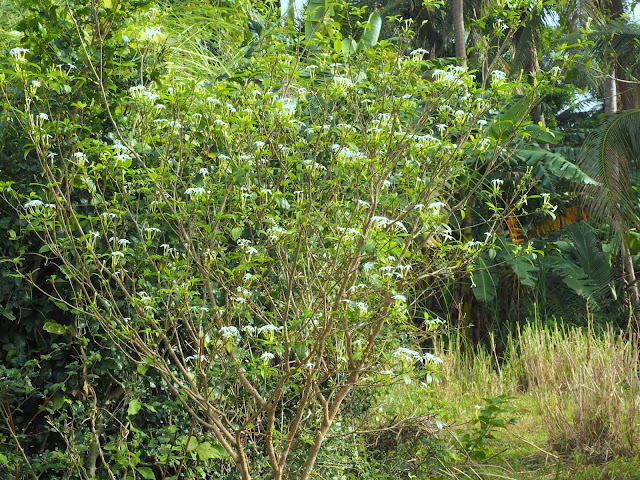The flowers are white with a bit wavy petals. They do not open simultaneously in big clusters unlike the umbels of some plants in the Apocynaceae family.
Flowers are just a little over 1 centimeter in diameter, but they are cute, don't you think so?
It looks like a spinning wheel, and it is loved also by some butterflies.
The fruits are technically called follicles, and normally emerge as a pair like above. They start as green which changes color as it ripens.
color already turning orange
The follicles eventually become orange as they ripen.
The black seeds are enclosed in red pulps, seemingly very attractive to eat. These pictures are just as i see them in the wild normal habitat. With those lots of seeds inside a folicle, i can imagine why there are lots of plants i see all around our area in the province.
Extracts of all parts of the pandacaqui plant is reported to have alkaloids and triterpenoids. It is also known to have medicinal properties. The internet is full of reports on its uses and concoctions and plants are being sold online.
In my area, i haven't known any use for medicinal purposes, but it is commonly used as landscape materials. It is not very difficult to grow and very tolerant to drought, which probably made it good in ornamental industry. I also observed it to be good nectar plants for some butterfy species, so it can be both used in landscaping and in butterfly gardening.









What a beautiful and interesting plant....love the colours of the fruit and seeds!
ReplyDeleteIt really looks interesting, though we haven't fully maximized its use yet.
Deletea new plant for me, love those flowers and interesting to see how it's turning in beautiful orange fruits.
ReplyDeleteYes it could be new, because it is a tropical species. Thanks for dropping by.
DeleteThe world of plants is endless. Spinning wheels indeed, so pretty & fresh. Interesting reading - thank you.
ReplyDeleteThanks Ritta K. Many flowers look like spinning wheels though.
DeleteI honestly have not seen these pods, but I am familiar with the flowers.
ReplyDeleteWorth a Thousand Words
YOu might just be misled because there are many flowers that look like that.
DeleteThat sounds like a great plant. I love the flowers and fruits and it is easy to look after and it feeds butterflies!! Perfect!
ReplyDeleteYes Nick, but not all butterflies go there or perhaps because they still have a choice. And they are just scattered in fallowed areas.
DeleteHello, sounds like a nice plant. I like the white flowers and orange leaves and fruit. Enjoy your day and week ahead!
ReplyDelete...a beauty that is new to me, thanks for sharing!
ReplyDeleteI always learn something new here Andrea...Michelle
ReplyDeleteThanks Michelle
DeleteI've never seen one like it, don't think we have anything like that here in NZ but we do have other plants which are drought tolerant yet also classed as noxious.
ReplyDeleteA very interesting plant - I like the look of the fruit - the outside and the inside!
ReplyDeleteThese are beautiful and very useful plants. I haven't seen any in Australia but saw them in Myanmar and was entranced.
ReplyDeleteMy reference says it is also native to Australia, maybe you have it in the Northern Territories and Queensland, more tropical climates.
DeleteLike little stars!
ReplyDelete